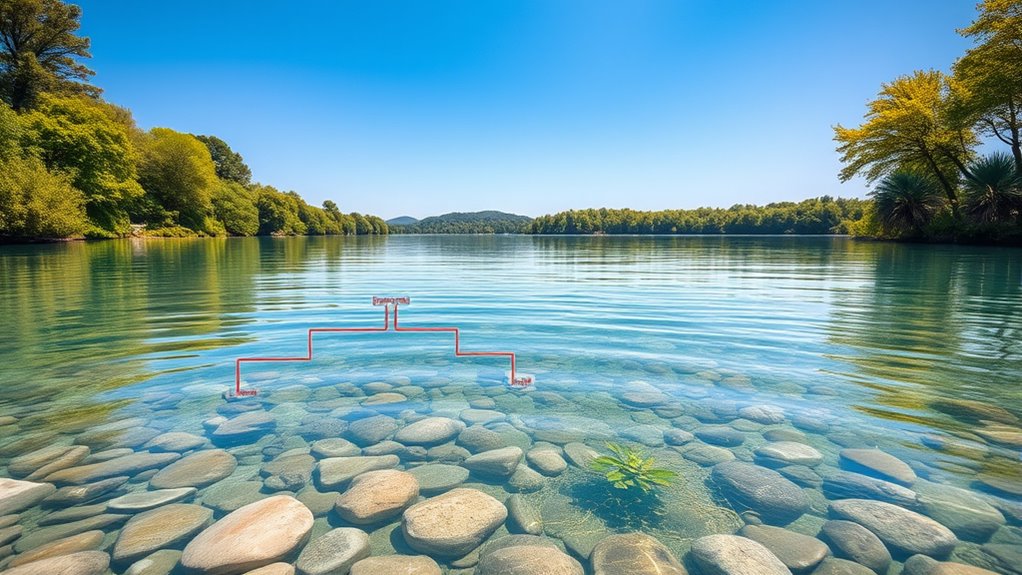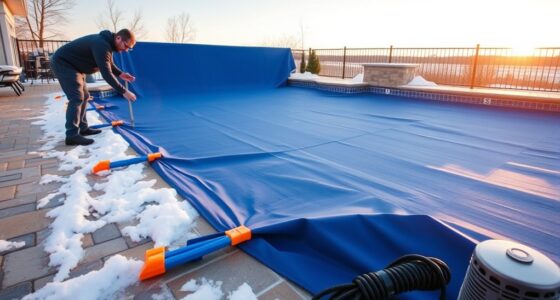To stop cloudy water fast, first identify if the cloudiness is a thin haze or dense fog—this helps determine if air bubbles or minerals cause it. Check your water chemistry and pH levels to see if imbalances exist. Inspect your filter and pump to ensure proper operation, and run them longer if needed. Address recent chemical additions or maintenance that could be affecting clarity. Following these steps can quickly improve your water, and there’s more to keep your pool crystal clear.
Key Takeaways
- Identify the cause of cloudiness (bubbles, minerals, debris) through visual inspection and water chemistry testing.
- Run your filter continuously and backwash or clean it to remove trapped particles.
- Add clarifier or shock treatments promptly to bond particles and clear the water quickly.
- Check and ensure proper pump operation and circulation to prevent stagnation and enhance filtration.
- Regularly monitor and adjust water chemistry levels to maintain clarity and prevent recurring cloudiness.
Identifying the Type of Cloudiness

Understanding the type of cloudiness in your water is essential for determining the right treatment. First, observe its appearance: does it look like a thin veil or a dense, milky fog? If it’s a light, uniform haze, it’s likely caused by air bubbles. These bubbles usually dissipate within minutes when the water sits undisturbed. On the other hand, if the cloudiness is thick and persistent, it might be due to dissolved minerals like calcium or magnesium, which can cause hard water. Sometimes, the water appears gritty or has visible particles, indicating suspended debris or algae. Recognizing these differences helps you decide whether to let the water sit, run a filter, or take other specific actions. Correct identification is the first step toward clearing your cloudy water quickly. Juice cleansing practices also highlight the importance of understanding your body’s responses to different substances, much like assessing water quality.
Checking Water Chemistry and Ph Levels
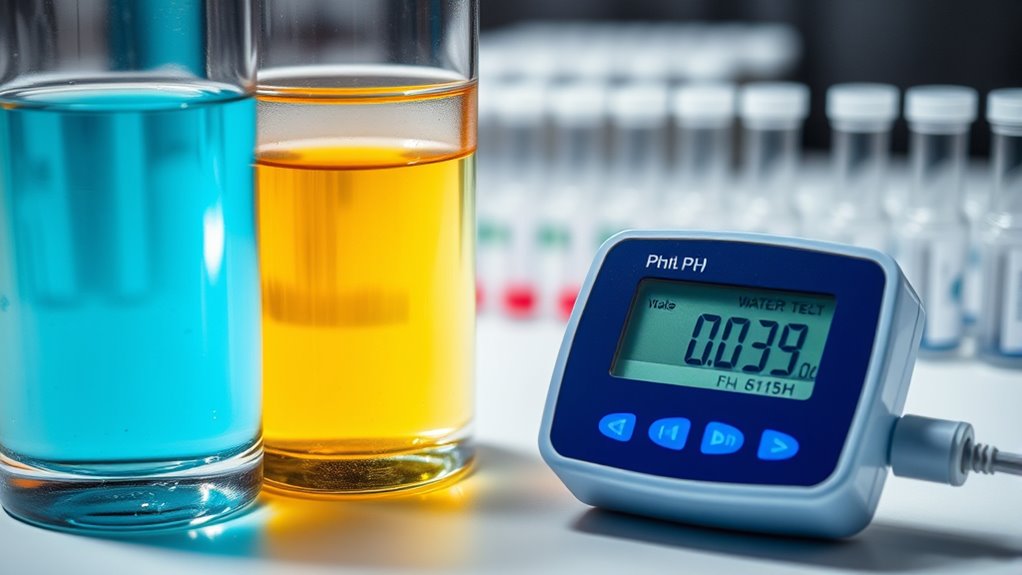
To effectively address cloudy water, you need to check its chemistry and pH levels since imbalances can be a primary cause. Testing helps you identify if your water is too acidic, alkaline, or has improper chemical levels that promote cloudiness. When you test, you gain clarity about what adjustments are necessary to restore clarity and ensure safe water. Regular monitoring of pimple patch ingredients can also help prevent skin irritation or adverse reactions during treatment. Here’s what you’ll want to focus on:
Testing your water’s chemistry and pH levels reveals imbalances causing cloudiness and guides quick, effective fixes.
- Discovering dangerous chemical imbalances that threaten your health and pool equipment
- Revealing pH levels that are either too low or too high, causing cloudiness
- Gaining confidence in your ability to troubleshoot and fix water issues quickly
- Taking control of your pool’s health instead of just guessing and hoping it clears up
Inspecting Filtration System Performance
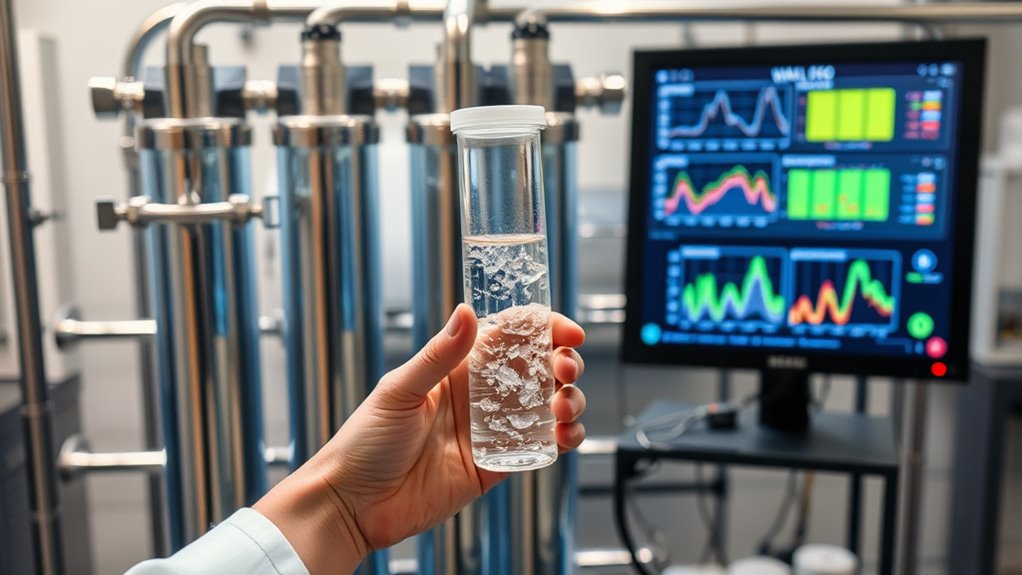
A properly functioning filtration system is essential for keeping your pool water clear. Start by inspecting the filter itself—look for visible dirt, debris, or damage. If you have a cartridge filter, remove it and check for clogs or tears; clean or replace it if necessary. For sand or DE filters, backwash the system to remove trapped particles, ensuring the water flows freely. Listen for unusual noises or leaks around the filter housing, which could indicate a problem. Confirm that the pump is operating correctly, with proper pressure levels indicated on the gauge. If pressure is too high or low, it can signal a clog or a need for maintenance. Regular inspection helps maintain ideal filtration, preventing cloudy water and keeping your pool crystal clear. Additionally, checking the filter type ensures you’re using the correct maintenance procedures for optimal performance.
Assessing Circulation and Pump Functionality
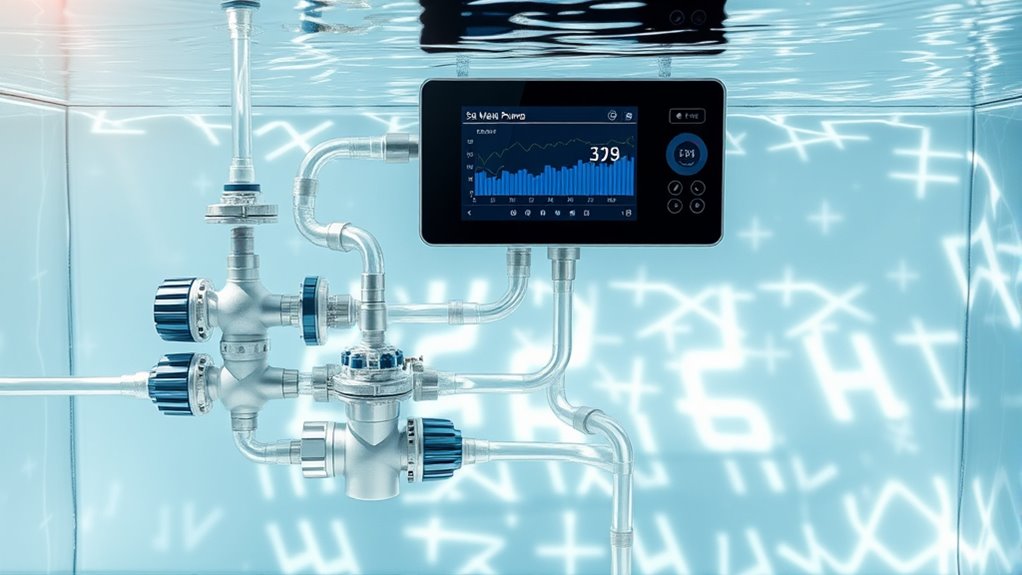
Ensuring proper circulation is key to maintaining clear pool water, so it’s important to evaluate your pump’s performance. If your water remains cloudy, check if your pump is running long enough each day—ideally 8-12 hours. Listen for unusual noises or vibrations, which can signal a problem. Verify that the pump’s impeller isn’t clogged or damaged, obstructing flow. Make sure the water returns evenly from all returns, indicating proper circulation. Proper pump placement can also influence water flow and clarity.
- Feel the flow at return jets; weak flow means a circulation issue.
- Notice if the pump sounds strained or inconsistent.
- Observe if debris or algae accumulate in your skimmer basket.
- Detect any strange odors or leaks around the pump area.
Addressing these signs promptly keeps water moving properly, preventing cloudiness and ensuring your pool stays inviting.
Evaluating Recent Maintenance or Chemical Additions
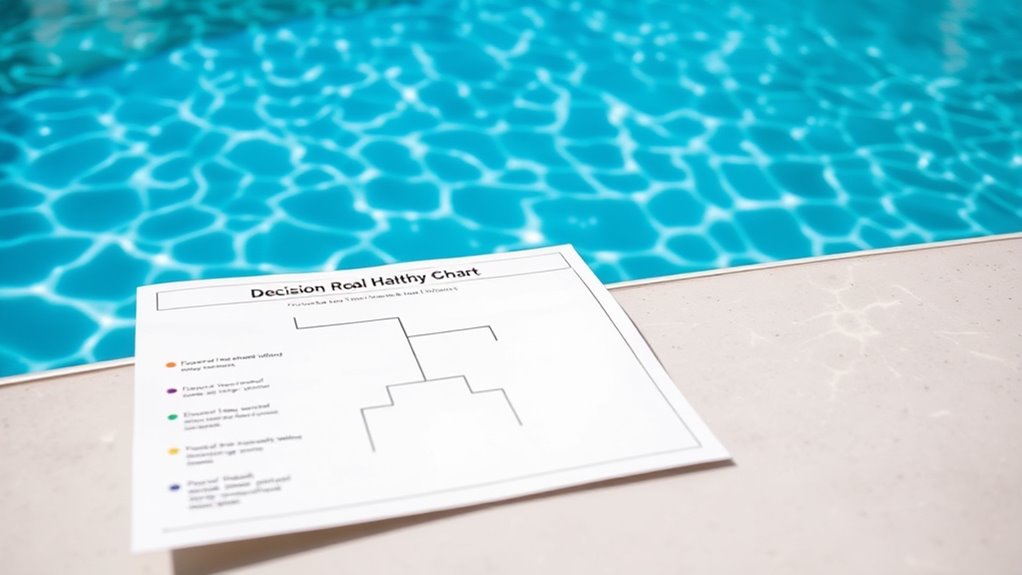
Review any recent chemical treatments you’ve added and note when they were applied. Check your maintenance history to see if major repairs or filter cleanings occurred recently. Consider the timing of chemical additions to determine if they might be causing the cloudiness.
Recent Chemical Treatments
Recent chemical treatments can profoundly impact water clarity, so it’s important to evaluate any recent maintenance or additions carefully. If chemicals like algaecides, clarifiers, or pH adjusters have been added recently, they might be causing cloudiness. Sometimes, overuse or incorrect dosing leads to unstable water conditions, making it appear murky. You should also check for signs of chemical imbalance or reactions with existing water treatments. Additionally, understanding Louisiana alimony laws can inform how financial adjustments might influence ongoing maintenance or treatment decisions, especially if recent changes in income or circumstances affect the situation. Be alert to these signs:
- Sudden change in water color or clarity
- Unusual chemical smells or foamy water
- Residue or scum buildup after treatment
- Persistent cloudiness despite proper filtration
Addressing recent chemical treatments promptly can help restore clarity and prevent ongoing issues.
Maintenance History Check
To diagnose water cloudiness effectively, start by examining your maintenance history for any recent chemical additions or adjustments. Think back over the past few days—did you add algaecide, shock, or pH adjusters? These changes can cause temporary cloudiness. Keep track of what chemicals you used, when, and in what amounts. To help visualize, here’s a quick overview:
| Chemical Added | Date | Effect on Water |
|---|---|---|
| Algaecide | 3 days ago | Possible cloudiness from residues |
| pH Up | 1 week ago | Usually stabilizes water |
| Shock Treatment | 2 days ago | Might cause temporary cloudiness |
| Clarifier | 5 days ago | Usually clears water |
| Enzyme Additive | 1 month ago | No recent effect |
This review helps identify if recent chemicals are causing the cloud, and understanding water chemistry can further aid in troubleshooting.
Timing of Additions
Timing plays a key role in pinpointing the cause of water cloudiness. If you recently added chemicals or performed maintenance, the timing of these actions can reveal whether they’re contributing to the problem. Think back to recent treatments—did you add too much shock or algaecide? Did you perform a filter cleaning right before the water turned cloudy? Sometimes, chemicals can overload the system or cause reactions that stir up debris. Recognizing these timing clues helps you act swiftly. Proper chemical balance is essential for maintaining clear water and preventing cloudiness.
Implementing Quick Fixes and Preventative Measures

When your water turns cloudy, quick fixes like using clarifiers or adjusting pH levels can restore clarity fast. To keep it from happening again, you’ll want to establish ongoing maintenance routines, such as regular filter cleaning and monitoring chemical balance. These steps help you address immediate issues and prevent future cloudy water problems effectively. Additionally, understanding the importance of proper water quality metrics can guide you in maintaining clear, healthy water over the long term.
Immediate Treatment Options
If your water has turned cloudy unexpectedly, quick action can help restore clarity. You need immediate treatment options to stop the cloudiness in its tracks. Start by running your filter continuously to trap particles. Consider adding a clarifier to bond small particles into larger clumps for easy removal. You might also temporarily increase your filtration time or use a shock treatment to eliminate bacteria and algae. Always test your water after treatment to ensure clarity and safety. Acting fast prevents the problem from worsening and keeps your water safe to use. Necessary cookies are essential for basic functionalities and can help ensure your treatment process runs smoothly. Taking swift action not only restores clarity but also helps maintain your pool or spa’s overall health.
- Feel the relief knowing you can fix it quickly before damage spreads
- Take control and prevent costly repairs later
- Protect your family’s health with swift action
- Regain clear, inviting water in no time
Ongoing Maintenance Tips
Once you’ve taken quick action to clear up cloudy water, maintaining that clarity becomes an ongoing priority. Regularly check your water chemistry, especially pH and chlorine levels, to prevent future cloudiness. Run your filter daily and clean it weekly to remove debris and buildup. Consider adding a clarifier or shock treatment monthly to keep water clear. Keep an eye on weather changes or heavy usage that can upset water balance. Prevent algae growth by maintaining proper sanitizer levels and using algaecide as needed. Drain and clean your pool periodically to remove dirt and residues. Cover the pool when not in use to minimize debris entry. Using a HEPA filtration system can also improve water clarity by removing airborne pollutants near the pool area. Consistent monitoring and routine maintenance help you avoid future cloudy water, saving time and effort in the long run.
Frequently Asked Questions
How Long Should I Wait Before Retesting After a Chemical Treatment?
You should wait at least 24 to 48 hours before retesting after a chemical treatment. This allows the chemicals to fully circulate and work through the water. During this time, run your pump and filter to help clear the water. Avoid disturbing the water or adding more chemicals until you’ve retested, ensuring the results are accurate and your pool is properly balanced for safe swimming.
Can Algae Cause Cloudy Water Even With a Good Filtration System?
Did you know algae is responsible for up to 70% of water cloudiness in pools? Yes, algae can cause cloudy water even with a good filtration system. Filtration alone might not remove algae entirely; you need to shock your pool with chlorine or algaecide to kill it. Regular brushing and proper chemical balance are essential. Don’t rely solely on filters—act quickly to keep your water crystal clear.
What Are Signs of a Broken Circulation Pump Besides Cloudy Water?
If your circulation pump is broken, you’ll notice poor water movement, which can cause stagnation. Look for uneven water flow or areas where water isn’t circulating properly. You might also see debris settling on the bottom or increased algae growth. Unusual noises from the pump or it not starting at all are clear signs. Address these issues promptly to prevent further water quality problems and keep your pool clear.
Is It Safe to Swim in Cloudy Water During Quick Fixes?
Like a cautious sailor steering foggy waters, you shouldn’t swim in cloudy water during quick fixes. It’s risky because the cloudiness might hide bacteria, algae, or other contaminants, posing health hazards. Instead, wait until the water clears and tests show safe levels. Protect your health and enjoy your pool responsibly—think of it as steering clear of hidden rocks while sailing through uncertain seas.
How Often Should I Perform Routine Water Testing for Clarity?
You should test your water at least once a week to maintain clarity and safety. If you notice any changes in color, smell, or if the water appears cloudy, test more frequently, ideally every couple of days. Regular testing helps you catch issues early, ensuring your water stays clear and safe for swimming. Keep a testing kit handy and record your results to track patterns over time.
Conclusion
By following these simple steps, you hold the power to clear your cloudy water quickly. Think of your pool as a living organism—when you understand its needs, you can restore its clarity with confidence. Don’t let cloudy water cloud your summer days; instead, become the detective who solves the mystery in minutes. With a little attention and quick action, your pool will shine as bright as your summer dreams.
